Abstract
1. Adenosine and adenosine 5'-triphosphate (ATP) have been reported to cause relaxation of the rat colon longitudinal muscle preparation; the purinoceptors mediating this effect were investigated by use of a series of agonists and antagonists. 2. The tissue was precontracted with carbachol (1 microM), and the purines induced reversible relaxations with a potency order of 5'-N-ethylcarboxamidoadenosine (NECA) greater than N6-cyclopentyladenosine (CPA) = adenosine 5'-(alpha, beta-methylene) triphosphonate (AMPCPP) greater than adenosine = adenylyl 5'-(beta, gamma-methylene) disphosphonate (AMPPCP) = ATP. The P1-selective antagonist 1,3-dipropyl-8-cyclopentylxanthine (DPCPX) (3 microM) shifted to the right the log concentration-response curves of all these agonists except for AMPCPP, indicating that they all act via P1-purinoceptors. The order of potency of the adenosine analogues and the relatively high concentrations of the antagonist required indicated that these receptors are of the A2 subtype. The P2-selective antagonist suramin (300 microM) inhibited responses to AMPCPP, but not to the other agonists. 3. The dephosphorylation of the nucleotides was studied by high performance liquid chromatography following incubation with the longitudinal muscle preparation for up to 30 min. ATP was rapidly degraded, largely to adenosine, and AMPPCP and AMPCPP were also degraded, although more slowly, to adenosine and adenosine 5'-(alpha, beta-methylene) diphosphonate (AMPCP) respectively. AMPCP, like AMPCPP, caused relaxations by acting on P2-purinoceptors, as it was also inhibited by suramin (300 microM). Incubation of the tissue with adenosine deaminase abolished responses to adenosine, reduced those to ATP and AMPPCP, but had no effect on those to AMPCPP.(ABSTRACT TRUNCATED AT 250 WORDS)
Full text
PDF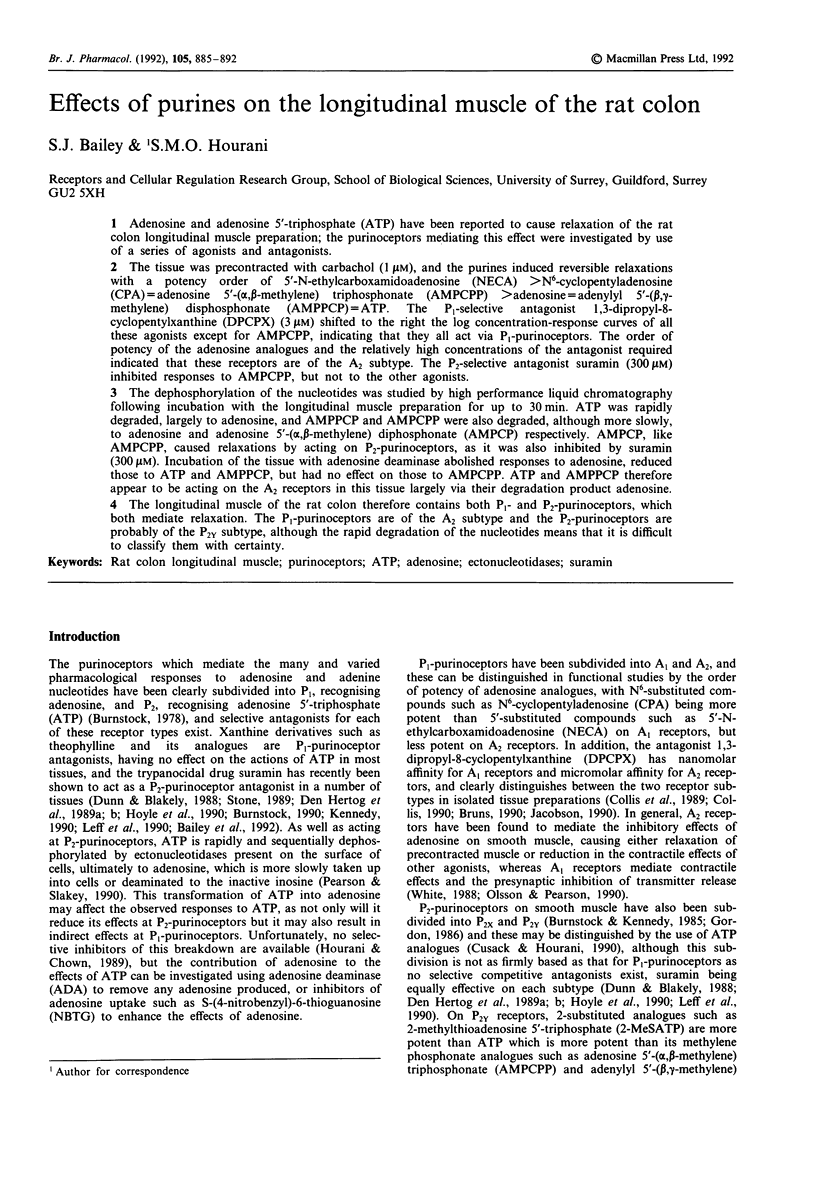
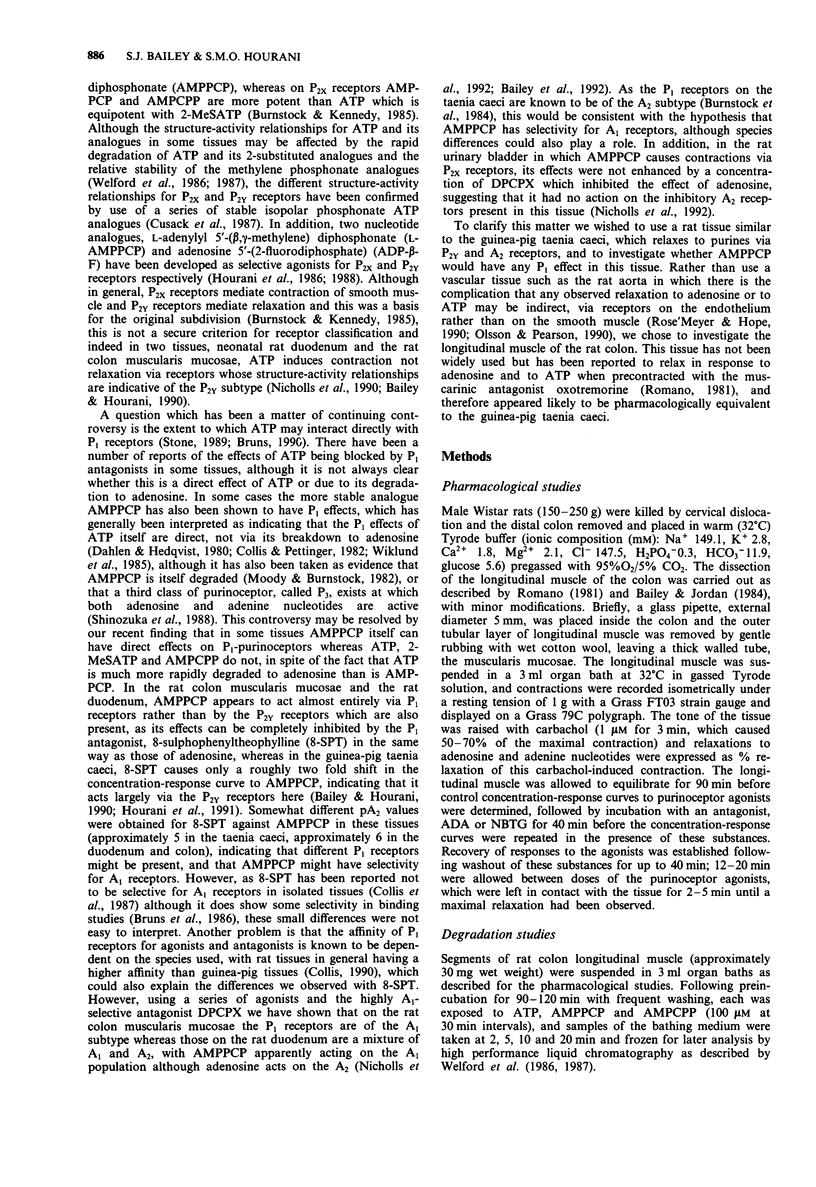
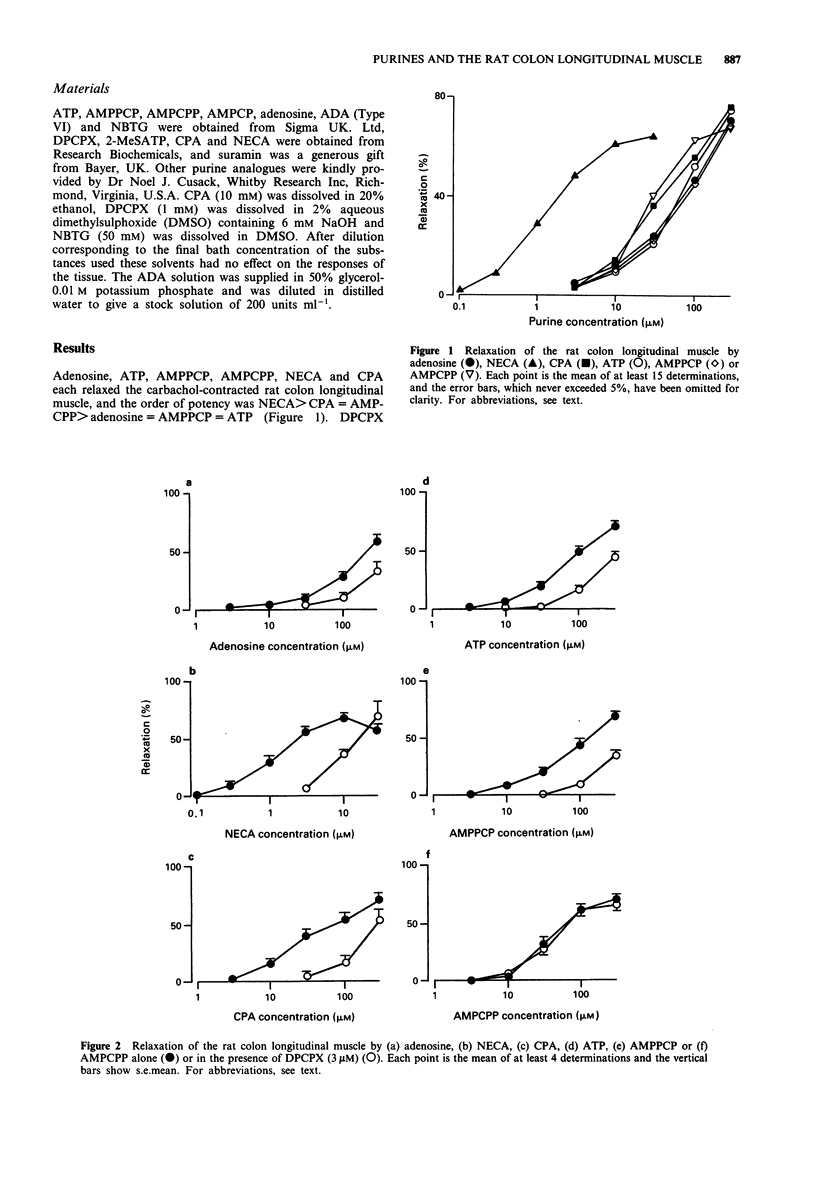

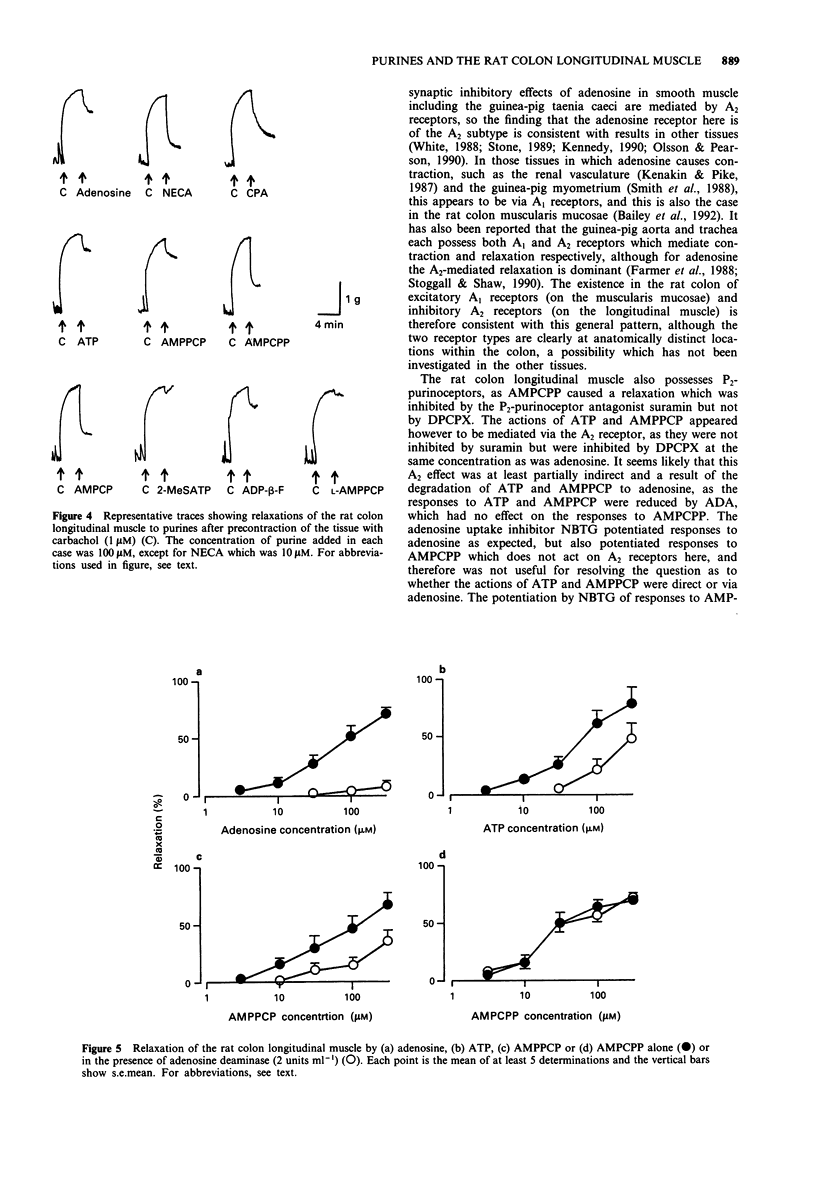

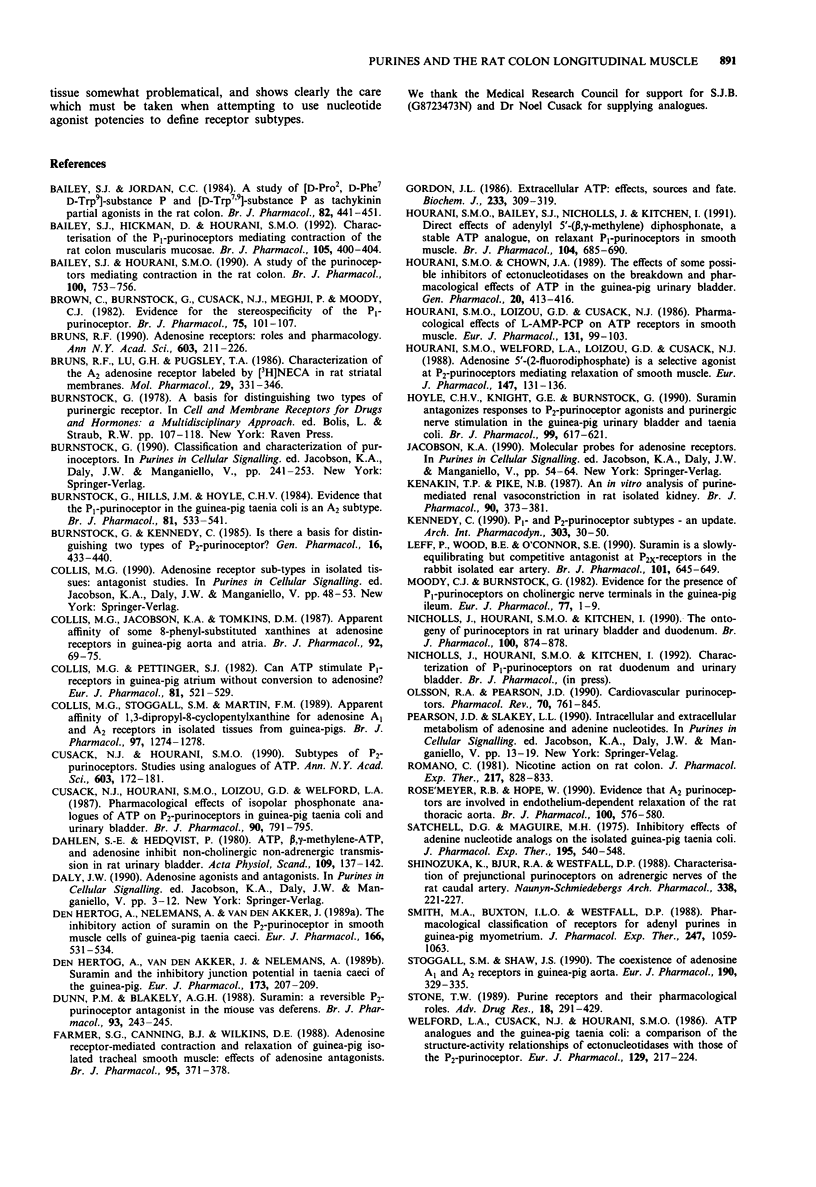

Selected References
These references are in PubMed. This may not be the complete list of references from this article.
- Bailey S. J., Hickman D., Hourani S. M. Characterization of the P1-purinoceptors mediating contraction of the rat colon muscularis mucosae. Br J Pharmacol. 1992 Feb;105(2):400–404. doi: 10.1111/j.1476-5381.1992.tb14265.x. [DOI] [PMC free article] [PubMed] [Google Scholar]
- Bailey S. J., Hourani S. M. A study of the purinoceptors mediating contraction in the rat colon. Br J Pharmacol. 1990 Aug;100(4):753–756. doi: 10.1111/j.1476-5381.1990.tb14087.x. [DOI] [PMC free article] [PubMed] [Google Scholar]
- Bailey S. J., Jordan C. C. A study of [D-Pro2, D-Phe7, D-Trp9]-substance P and [D-Trp7,9]-substance P as tachykinin partial agonists in the rat colon. Br J Pharmacol. 1984 Jun;82(2):441–451. doi: 10.1111/j.1476-5381.1984.tb10779.x. [DOI] [PMC free article] [PubMed] [Google Scholar]
- Brown C., Burnstock G., Cusack N. J., Meghji P., Moody C. J. Evidence for stereospecificity of the P1-purinoceptor. Br J Pharmacol. 1982 Jan;75(1):101–107. doi: 10.1111/j.1476-5381.1982.tb08762.x. [DOI] [PMC free article] [PubMed] [Google Scholar]
- Bruns R. F. Adenosine receptors. Roles and pharmacology. Ann N Y Acad Sci. 1990;603:211–226. doi: 10.1111/j.1749-6632.1990.tb37674.x. [DOI] [PubMed] [Google Scholar]
- Bruns R. F., Lu G. H., Pugsley T. A. Characterization of the A2 adenosine receptor labeled by [3H]NECA in rat striatal membranes. Mol Pharmacol. 1986 Apr;29(4):331–346. [PubMed] [Google Scholar]
- Burnstock G., Hills J. M., Hoyle C. H. Evidence that the P1-purinoceptor in the guinea-pig taenia coli is an A2-subtype. Br J Pharmacol. 1984 Mar;81(3):533–541. doi: 10.1111/j.1476-5381.1984.tb10106.x. [DOI] [PMC free article] [PubMed] [Google Scholar]
- Burnstock G., Kennedy C. Is there a basis for distinguishing two types of P2-purinoceptor? Gen Pharmacol. 1985;16(5):433–440. doi: 10.1016/0306-3623(85)90001-1. [DOI] [PubMed] [Google Scholar]
- Collis M. G., Jacobson K. A., Tomkins D. M. Apparent affinity of some 8-phenyl-substituted xanthines at adenosine receptors in guinea-pig aorta and atria. Br J Pharmacol. 1987 Sep;92(1):69–75. doi: 10.1111/j.1476-5381.1987.tb11297.x. [DOI] [PMC free article] [PubMed] [Google Scholar]
- Collis M. G., Pettinger S. J. Can ATP stimulate P1-receptors in guinea-pig atrium without conversion to adenosine? Eur J Pharmacol. 1982 Jul 30;81(4):521–529. doi: 10.1016/0014-2999(82)90341-7. [DOI] [PubMed] [Google Scholar]
- Collis M. G., Stoggall S. M., Martin F. M. Apparent affinity of 1,3-dipropyl-8-cyclopentylxanthine for adenosine A1 and A2 receptors in isolated tissues from guinea-pigs. Br J Pharmacol. 1989 Aug;97(4):1274–1278. doi: 10.1111/j.1476-5381.1989.tb12589.x. [DOI] [PMC free article] [PubMed] [Google Scholar]
- Cusack N. J., Hourani S. M., Loizou G. D., Welford L. A. Pharmacological effects of isopolar phosphonate analogues of ATP on P2-purinoceptors in guinea-pig taenia coli and urinary bladder. Br J Pharmacol. 1987 Apr;90(4):791–795. doi: 10.1111/j.1476-5381.1987.tb11233.x. [DOI] [PMC free article] [PubMed] [Google Scholar]
- Cusack N. J., Hourani S. M. Subtypes of P2-purinoceptors. Studies using analogues of ATP. Ann N Y Acad Sci. 1990;603:172–181. doi: 10.1111/j.1749-6632.1990.tb37671.x. [DOI] [PubMed] [Google Scholar]
- Dahlén S. E., Hedqvist P. ATP, beta-gamma-methylene-ATP, and adenosine inhibit non-cholinergic non-adrenergic transmission in rat urinary bladder. Acta Physiol Scand. 1980 Jun;109(2):137–142. doi: 10.1111/j.1748-1716.1980.tb06578.x. [DOI] [PubMed] [Google Scholar]
- Den Hertog A., Van den Akker J., Nelemans A. Suramin and the inhibitory junction potential in taenia caeci of the guinea-pig. Eur J Pharmacol. 1989 Dec 7;173(2-3):207–209. doi: 10.1016/0014-2999(89)90522-0. [DOI] [PubMed] [Google Scholar]
- Dunn P. M., Blakeley A. G. Suramin: a reversible P2-purinoceptor antagonist in the mouse vas deferens. Br J Pharmacol. 1988 Feb;93(2):243–245. doi: 10.1111/j.1476-5381.1988.tb11427.x. [DOI] [PMC free article] [PubMed] [Google Scholar]
- Farmer S. G., Canning B. J., Wilkins D. E. Adenosine receptor-mediated contraction and relaxation of guinea-pig isolated tracheal smooth muscle: effects of adenosine antagonists. Br J Pharmacol. 1988 Oct;95(2):371–378. doi: 10.1111/j.1476-5381.1988.tb11655.x. [DOI] [PMC free article] [PubMed] [Google Scholar]
- Gordon J. L. Extracellular ATP: effects, sources and fate. Biochem J. 1986 Jan 15;233(2):309–319. doi: 10.1042/bj2330309. [DOI] [PMC free article] [PubMed] [Google Scholar]
- Hourani S. M., Bailey S. J., Nicholls J., Kitchen I. Direct effects of adenylyl 5'-(beta,gamma-methylene)diphosphonate, a stable ATP analogue, on relaxant P1-purinoceptors in smooth muscle. Br J Pharmacol. 1991 Nov;104(3):685–690. doi: 10.1111/j.1476-5381.1991.tb12489.x. [DOI] [PMC free article] [PubMed] [Google Scholar]
- Hourani S. M., Chown J. A. The effects of some possible inhibitors of ectonucleotidases on the breakdown and pharmacological effects of ATP in the guinea-pig urinary bladder. Gen Pharmacol. 1989;20(4):413–416. doi: 10.1016/0306-3623(89)90188-2. [DOI] [PubMed] [Google Scholar]
- Hourani S. M., Loizou G. D., Cusack N. J. Pharmacological effects of L-AMP-PCP on ATP receptors in smooth muscle. Eur J Pharmacol. 1986 Nov 12;131(1):99–103. doi: 10.1016/0014-2999(86)90521-2. [DOI] [PubMed] [Google Scholar]
- Hourani S. M., Welford L. A., Loizou G. D., Cusak N. J. Adenosine 5'-(2-fluorodiphosphate) is a selective agonist at P2-purinoceptors mediating relaxation of smooth muscle. Eur J Pharmacol. 1988 Feb 16;147(1):131–136. doi: 10.1016/0014-2999(88)90642-5. [DOI] [PubMed] [Google Scholar]
- Hoyle C. H., Knight G. E., Burnstock G. Suramin antagonizes responses to P2-purinoceptor agonists and purinergic nerve stimulation in the guinea-pig urinary bladder and taenia coli. Br J Pharmacol. 1990 Mar;99(3):617–621. doi: 10.1111/j.1476-5381.1990.tb12979.x. [DOI] [PMC free article] [PubMed] [Google Scholar]
- Kenakin T. P., Pike N. B. An in vitro analysis of purine-mediated renal vasoconstriction in rat isolated kidney. Br J Pharmacol. 1987 Feb;90(2):373–381. doi: 10.1111/j.1476-5381.1987.tb08967.x. [DOI] [PMC free article] [PubMed] [Google Scholar]
- Kennedy C. P1- and P2-purinoceptor subtypes--an update. Arch Int Pharmacodyn Ther. 1990 Jan-Feb;303:30–50. [PubMed] [Google Scholar]
- Leff P., Wood B. E., O'Connor S. E. Suramin is a slowly-equilibrating but competitive antagonist at P2x-receptors in the rabbit isolated ear artery. Br J Pharmacol. 1990 Nov;101(3):645–649. doi: 10.1111/j.1476-5381.1990.tb14134.x. [DOI] [PMC free article] [PubMed] [Google Scholar]
- Moody C. J., Burnstock G. Evidence for the presence of P1-purinoceptors on cholinergic nerve terminals in the guinea-pig ileum. Eur J Pharmacol. 1982 Jan 8;77(1):1–9. doi: 10.1016/0014-2999(82)90527-1. [DOI] [PubMed] [Google Scholar]
- Nicholls J., Hourani S. M., Kitchen I. The ontogeny of purinoceptors in rat urinary bladder and duodenum. Br J Pharmacol. 1990 Aug;100(4):874–878. doi: 10.1111/j.1476-5381.1990.tb14107.x. [DOI] [PMC free article] [PubMed] [Google Scholar]
- Olsson R. A., Pearson J. D. Cardiovascular purinoceptors. Physiol Rev. 1990 Jul;70(3):761–845. doi: 10.1152/physrev.1990.70.3.761. [DOI] [PubMed] [Google Scholar]
- Romano C. Nicotine action on rat colon. J Pharmacol Exp Ther. 1981 Jun;217(3):828–833. [PubMed] [Google Scholar]
- Rose'Meyer R. B., Hope W. Evidence that A2 purinoceptors are involved in endothelium-dependent relaxation of the rat thoracic aorta. Br J Pharmacol. 1990 Jul;100(3):576–580. doi: 10.1111/j.1476-5381.1990.tb15849.x. [DOI] [PMC free article] [PubMed] [Google Scholar]
- Satchell D. G., Maguire M. H. Inhibitory effects of adenine nucleotide analogs on the isolated guinea-pig taenia coli. J Pharmacol Exp Ther. 1975 Dec;195(3):540–548. [PubMed] [Google Scholar]
- Shinozuka K., Bjur R. A., Westfall D. P. Characterization of prejunctional purinoceptors on adrenergic nerves of the rat caudal artery. Naunyn Schmiedebergs Arch Pharmacol. 1988 Sep;338(3):221–227. doi: 10.1007/BF00173391. [DOI] [PubMed] [Google Scholar]
- Smith M. A., Buxton I. L., Westfall D. P. Pharmacological classification of receptors for adenyl purines in guinea pig myometrium. J Pharmacol Exp Ther. 1988 Dec;247(3):1059–1063. [PubMed] [Google Scholar]
- Stoggall S. M., Shaw J. S. The coexistence of adenosine A1 and A2 receptors in guinea-pig aorta. Eur J Pharmacol. 1990 Nov 13;190(3):329–335. doi: 10.1016/0014-2999(90)94197-6. [DOI] [PubMed] [Google Scholar]
- Welford L. A., Cusack N. J., Hourani S. M. ATP analogues and the guinea-pig taenia coli: a comparison of the structure-activity relationships of ectonucleotidases with those of the P2-purinoceptor. Eur J Pharmacol. 1986 Oct 7;129(3):217–224. doi: 10.1016/0014-2999(86)90431-0. [DOI] [PubMed] [Google Scholar]
- Welford L. A., Cusack N. J., Hourani S. M. The structure-activity relationships of ectonucleotidases and of excitatory P2-purinoceptors: evidence that dephosphorylation of ATP analogues reduces pharmacological potency. Eur J Pharmacol. 1987 Sep 2;141(1):123–130. doi: 10.1016/0014-2999(87)90418-3. [DOI] [PubMed] [Google Scholar]
- White T. D. Role of adenine compounds in autonomic neurotransmission. Pharmacol Ther. 1988;38(2):129–168. doi: 10.1016/0163-7258(88)90095-2. [DOI] [PubMed] [Google Scholar]
- Wiklund N. P., Gustafsson L. E., Lundin J. Pre- and postjunctional modulation of cholinergic neuroeffector transmission by adenine nucleotides. Experiments with agonist and antagonist. Acta Physiol Scand. 1985 Dec;125(4):681–691. doi: 10.1111/j.1748-1716.1985.tb07771.x. [DOI] [PubMed] [Google Scholar]
- den Hertog A., Nelemans A., Van den Akker J. The inhibitory action of suramin on the P2-purinoceptor response in smooth muscle cells of guinea-pig taenia caeci. Eur J Pharmacol. 1989 Aug 3;166(3):531–534. doi: 10.1016/0014-2999(89)90370-1. [DOI] [PubMed] [Google Scholar]


